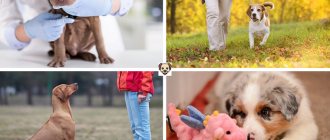An owner who carefully watches his four-legged pet can easily notice if the dog is trembling and lethargic. This can be caused by ordinary physiological reasons, such as cold or stress, or more serious ones associated with various diseases. In the first case, the symptoms disappear after eliminating their source, but the second case requires more careful monitoring of the pet, and in some cases even contacting a veterinarian.
The pet is shaking. Any reason to worry?
When the dog is trembling, you need to watch it for a few minutes. Most often, the tremor goes away without consequences.
There are physiological and pathological causes of trembling in dogs. Impressive dogs of small decorative breeds begin to tremble for any reason, and after a few minutes they calm down. Age-related changes predispose to tremor.
Cold
The most common reason why a dog's hind legs tremble or his whole body shakes is cold. If the dog is cold, shivering is a normal adaptive reaction of his body to the low ambient temperature. Animals of breeds such as Spitz, Chihuahua or Yorkie are susceptible to cold and react to it immediately. Shivering is an effective mechanism for protecting the body from hypothermia. To protect your pet from the negative effects of low temperatures, you need to take care of his comfort. When going for a walk, you should wear special clothes, and maintain a normal temperature in the house. These recommendations will be useful for those people who want to find out why their Yorkie dog is trembling.
Non-Dangerous Causes of Trembling
The following causes of trembling are considered safe:
- Emotional condition,
- Hypothermia,
- Sexual desire.
Emotional states
The dogs rejoice at the return of their owner, they are afraid of thunder, of another dog. Animals experience fear during transportation, at the sight of a veterinary clinic where she was hurt. More often than others, small dogs of some breeds and puppies shake with fear. Animals are frightened by rockets, explosions of firecrackers, loud shouts, and beatings.
Hypothermia
Dog owners believe that their pets heat themselves from the inside if they have enough food. Sled dogs with thick hair feel normal in temperatures of fifty degrees below zero. But decorative dogs with sparse fur freeze at above-zero temperatures after a short walk. Frost is not as bad as dampness, wind, sleet, or rain.
Sexual desire
Males detect a bitch in heat by scent. The gonads release testosterone into the blood. The dog is trembling, whining, fussing. When the object of interest is removed or the resourceful owner distracts the pet’s attention with something entertaining, the trembling goes away
“Shaking” dogs: characteristics of small pets - Yorkies, toy terriers and others
Yorkshire Terrier Owners of Yorkshire Terriers are not surprised that their pets often tremble.
This is a normal reaction to cold. The body of these animals is so small that to warm it, it is necessary to accelerate the blood flow, and trembling helps to avoid hypothermia. In addition to the Yorkie, the "shaky" breed category also includes the Spitz, Italian Greyhound and Chihuahua. To prevent these animals from freezing, their owners should not take them out for a walk without warm clothing. Share with friends!
Injuries, vaccinations and post-operative period
Immediately after an injury and during the recovery period, trembling causes pain. Post-vaccination complications are accompanied by an increase in body temperature.
When recovering from anesthesia, your pet will experience chills as the temperature drops below normal. Feverish phenomena are accompanied by muscular tremors. With spinal cord injuries, damage to the nervous system, contusions, certain parts of the body shake and paralysis of the limbs develops.
Viral diseases
Mostly unvaccinated puppies get sick. Bacterial microflora joins the causative agents of canine distemper, parvovirus enteritis, and adenovirus.
Neurotoxic substances accumulate in the blood, causing convulsions, paresis, and muscle tremors. Additional symptoms indicate the infectious nature of the disease: diarrhea, vomiting, refusal to eat and drink.
Diseases and parasite infestations
After an ixodid tick attack, the dog develops a severe blood parasitic disease - babesiosis. Piroplasmas feed on red blood cells, causing symptoms of anemia. The waste products of protozoan parasites are poisonous, causing tremors, convulsions, diarrhea, and vomiting. Similar symptoms, but less pronounced, are recorded with severe infestation.
Hypoglycemia
A decrease in blood sugar levels below normal is characterized by muscle tremors, loss of consciousness and falling into a coma.
Pathological symptoms develop for the following reasons:
- insulin overdose when treating dogs with diabetes;
- physical overload during hunting;
- malignant neoplasm of the pancreas;
- Juvenile hypoglycemia in adolescent toy breeds.
Fasting does not cause a drop in blood sugar: the body synthesizes glucose from fats and proteins in the body.
Allergic reaction
Additional signs indicate the allergic nature of the trembling: the animal itches, lacrimation develops, and rashes appear on the skin.
Diseases of internal organs
The following additional signs indicate internal non-communicable diseases:
- weakness, lack of coordination - in cardiovascular pathologies;
- unsteady gait is observed in hypothyroidism;
- weakness of the paws occurs when there is an imbalance of calcium, sodium, potassium, and other minerals;
- drooling and paroxysms raise suspicions of epilepsy;
When a pet is diagnosed with kidney or liver failure, muscle tremors appear during periods of exacerbation.
Poisoning
In case of an overdose of veterinary drugs, tubazide poisoning, the brain is affected and impulses between muscles and nerves are interrupted. The animal is trembling and drooling. After treating a dog to chocolate, anxiety, vomiting, spasms, and muscle tremors occur.
Heatstroke
When a dog is locked in a car, a stuffy room, or is outside in hot, cloudy weather with no wind, there is a risk of heatstroke. Brain swelling develops, which is manifested by muscle tremors and convulsions.
Pain syndrome
Pain is not an independent disease, but a sign of an underlying pathology. The pet refuses to eat, drink, and tries to take a position in which the pain is relieved. Additional symptoms appear: vomiting, diarrhea, cough, pale or yellowing of the mucous membranes.
Older dogs and animals with congenital abnormalities develop joint disease. During exacerbations, severe pain occurs, which is accompanied by tremors.
Viral hepatitis
Hepatitis is a very insidious virus that can be transmitted not only through direct contact with an infected animal. It is easy to become infected while walking, as the virus can remain active for a very long time. Typically, young animals are susceptible to hepatitis in the first year of life, but cases of the disease are known at a later age.
Viral hepatitis may be the reason why a dog is constantly trembling, since it primarily affects the animal's nervous system. Along with tremor, the dog experiences damage to internal organs and loss of coordination. In such cases, contacting the clinic is mandatory, and as soon as possible.
How to help your pet
It is necessary to analyze the situation, identify the cause of muscle tremors, and, if possible, prevent its onset. Trembling is considered harmless if it is not accompanied by additional symptoms, but appears from time to time when provoking situations are repeated.
How to eliminate harmless tremors
Animals of decorative breeds are not walked in bad weather, but are dressed in frosty and damp weather.
To calm tremors caused by an emotional state, the pet is distracted from the stimulus with a treat or offered to play. When stressful situations are often repeated and occur without additional symptoms, sedatives such as Stop Stress help. The dog owner should know when a stressful event will occur and use a sedative several days before the alarming event.
To prevent hypothermia, dogs living in the yard should have their kennels insulated and ensure that the feeder is not left empty. Animals of decorative breeds are not walked in bad weather, but are dressed in frosty and damp weather. You can use a store-bought jumpsuit or make your own sweater. The dog does not freeze, and its funny appearance improves the mood of the owner.
To weaken the male's sexual desire, medications are used or increased physical activity. An overly aggressive dog will be neutered.
Animals that experience prolonged physical overload are provided with special ready-made food.
What should I do?
Depending on what causes the tremor, methods for eliminating it are selected. If the trembling is caused by natural causes, it is enough to take the following steps:
- If your pet is cold, put on warm overalls before a walk or reduce the duration of exercise;
- Dry the coat thoroughly immediately after bathing. To be sure, you can wrap your dog in a warm blanket;
- Minimize stressful situations , and if necessary, give your pet a special soothing tea.
- Winter, winter... If the trembling has been going on for a long time and does not have a single natural cause, you must immediately contact a specialist.
Timely diagnosis and proper treatment of the disease can save your dog’s life! A correct diagnosis can only be made based on the results of examinations and tests. Depending on this, treatment is selected:
- Allergies – removal of allergens and a course of antihistamines;
- Helminthiasis - a course of anthelmintic drugs and minimizing contact with a person to avoid the risk of infection of the latter;
- Hypoglycemia - glucose injections. However, advanced disease requires more serious treatment;
- Piroplasmosis – antiviral vaccine along with supportive therapy;
- Pain syndrome - the dog is able to cope with minor wounds on its own - you just need to make sure that the injury site does not fester. More severe cases, including closed injuries, require veterinary intervention.
Shaking and signs of a cold in a dog
Hello, the dog is shaking all over, can barely walk, his eyes are red, his nose is stuffy, he eats and drinks little. In a dream, it constantly twitches, shocks are heard in the cranial region, the jaw constantly trembles, and sneezes. What to do?
Answer 4
The kidneys are an organ that maintains the water-salt balance of the body. They remove harmful substances, toxins and other substances. Organ functions are impaired. Diseases develop. The tissues that form the organ die, which causes autointoxication. The water-salt balance is shaken. Dogs of different breeds, ages, and weight categories are at risk. The disease manifests itself at a late stage.
The disease manifests itself in various ways: acute, chronic forms. The acute form occurs suddenly. Eliminated by treatment. Symptoms are characteristic of the early stages. Contribute to the development of infection, parasites, poisoning, dehydration. Problems with urination make the situation worse.
The chronic form is typical for old dogs. Causes lifelong impairment of organ functions. The kidneys are failing. This is a typical ailment of older animals. It is provoked by the lack of treatment of acute forms of diseases and pathologies.
Symptoms
The acute form of the malaise affects appetite and thirst. Accompanied by frequent urination. The pet experiences weakness, lethargy, and does not respond. The dog refuses to get up and constantly lies down.
The body gradually swells. The body temperature rises. The mucous membrane turns pale and acquires a bluish tint. The oral cavity becomes covered with ulcers.
Chronic malaise is accompanied by thirst and rare trips to relieve oneself. Body temperature decreases. The mucous membranes are dry, the nose is hot. There is a pungent odor coming from the mouth.
The body is exhausted. Weakness is accompanied by vomiting and diarrhea. The animal refuses to eat. Reacts poorly to irritability. The body is chilling.
Help
Providing assistance requires an accurate diagnosis. The animal needs to be examined by a doctor. A number of studies are being carried out. Tests are being taken.
Internal solutions are used to relieve intoxication. Bacteria are destroyed by taking antibiotics. Cleanses the blood. The body undergoes thorough cleaning.
Treatment is accompanied by taking heart medications. Probiotics are prescribed to normalize the functioning of the digestive system. It is recommended to take vitamins. A balanced diet is maintained.
Food containing phosphorus compounds is prohibited: buckwheat porridge, fermented milk products. Reduce the percentage of fish, meat, chicken in the diet. The normal functioning of the affected organs is supported by the consumption of vegetables and foods containing vegetable fats.
Meals are repeated four or five times a day. Small portions are provided. Products are thermally processed. Shredded food is digested faster.
It is prohibited to give bones to your pet. Also prohibited are sausages, cheeses, smoked foods, and sweets. Broths, porridges, boiled minced meat, and cooked vegetables are considered healthy dishes. Food is flavored with oil. The pet store market offers ready-made food for dogs with kidney failure. Veterinarian consultation required.
Red eyes
Sleepy animals have reddened eyes. Other situations signal illness. Tears accompanied by discharge of blood and pus indicate the presence of a brain or eye injury. Accompanied by dilation of the pupils and the appearance of blood vessels.
The eyeballs could be affected by a foreign body or chemicals. Evidence of swelling in the area, paws reaching towards the eyes, blinking, tears. The dog will whine and scratch its face. It is necessary to isolate the affected area.
Allergies cause coughing and sneezing. Eyes turn red. Tears and snot flow. It is difficult for the patient to breathe - the mucous membrane swells. This is how the body reacts to chemicals and irritants.
The body reacts to the virus with reddened organs of vision. The cornea becomes cloudy. Tear production increases. The eye area swells. The dog blinks frequently.
High blood pressure causes you to vomit blood. Vision decreases. The patient breathes quickly. Fainting is possible.
Anemia is a lack of iron-containing substances. In addition to redness, breathing problems arise. The mucous membranes turn pale. The desire to eat disappears, lethargy is present.
Prevention of bruxism
Bruxism can be prevented by paying attention to oral health: it is important to see a dentist in a timely manner, treat diseases of the teeth and gums, and restore the integrity of the dentition if teeth are lost. If you have bite defects or crowded teeth, you should consult an orthodontist.
Prevention involves normalizing the psycho-emotional state, giving up bad habits, coffee and energy drinks; maintaining a daily routine and proper nutrition.
Specialists from STOMA clinics will help adult patients get rid of bruxism: with us you can get help from all specialized doctors - from dental therapists to periodontists and orthodontists.











